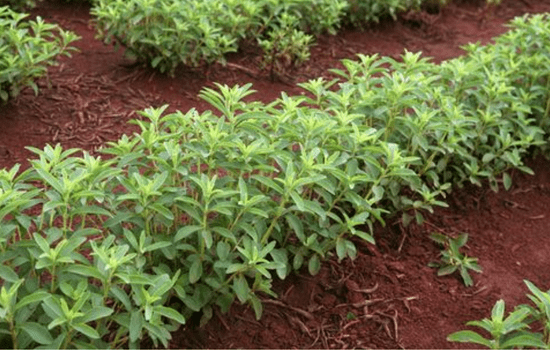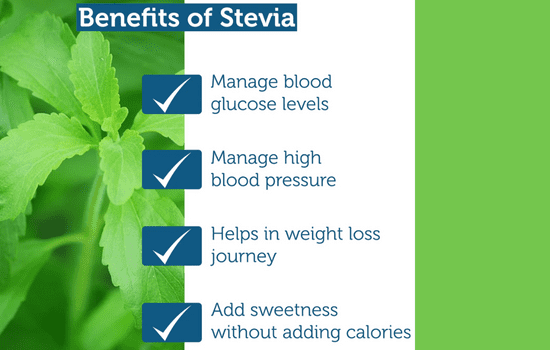Stevia plant has a strong sweet flavor that has been used to sweeten drinks and prepare tea since the 16th century. Its origin is from Paraguay and Brazil, the plant is currently grown in China and Japan. People use it as a herbal supplement and a calorie sweetener. Many meals and beverages substitute stevia because of its no calories nature and as a healthy option.
In 1987, the Food and Drug Administration (FDA) of the United States prohibited the commercialization of stevia as a food additive. However, stevia recovered its reputation as a sweet, long-lasting food additive in 1995. Since then, stevia-containing products have increased in number by 58 percent, reflecting the sweetener’s rising popularity.
About Stevia Plant
A flowering plant in the aster family known as Stevia rebaudiana, often known as sweet leaf or candy leaf, is cultivated for its sweet-tasting leaves. The Guaran people of Paraguay have long used the plant there, where it is native.
The leaves contain several sweet-tasting substances called steviol glycosides, which can be processed commercially to create powdered noncaloric sweeteners. Steviol glycosides can be used fresh or dried to sweeten beverages or desserts. It is famous as a healthier substitute for sugar, stevia sweeteners gained popularity across the globe in the early twenty-first century.
Also read: Best Weed Killer
Complete guide on the growing of Stevia plant

Despite having a common green appearance, the Stevia plant is an interesting selection for the herb garden due to the naturally calorie-free sweetness present in its leaves. Stevia is a delicate plant that enjoys the warm sun and perishes in a freeze. It is popular among dieters and diabetics.
However, on warm days, the roots generally sustain the winter and in spring you can see its growth. With protection, it can also survive the winter. Stevia is grown year-round by gardeners in regions without cold, where it can develop into a tiny shrub. However, strength starts to decrease after the second year, so replanting is beneficial if you want to collect the most leaves possible.
Soil selection
Take loamy soil but it should be well-drained soil. Plant your stevia so that it has about 18 inches of room to call its own. In the loose, loamy, well-drained soil, it will grow 1 to 3 feet in height, depending on the length of the growing season. Wait until after all danger of frost has passed before planting.
Plant Position
It should be placed in full sun to partial afternoon shade.
Frost tolerant capacity
Stevia is a delicate plant grown vegetatively and propagated annually. Parent plants kept indoors over the winter produce stems that can be rooted in the spring.
Need of fertilizers
They are not generally needed. If you feel the need you can add water-soluble fertilizer in midsummer to invigorate plants.
Sowing and Planting options
You can also begin with a purchased plant because stevia seeds take time to sprout. you can also grow it with the assistance of a grown stevia plant root cutting so that you can grow it at your home.
Problems with the planting
The roots of stevia could decay if the soil is too wet, so make sure the area has sufficient drainage. The plant shrinking and failing to recover after watering is a sure symptom of decay. But there is one thing that very few pests attack stevia plants.
Harvesting and storage
In the autumn’s cold temperatures, leaves are at their tastiest point. Moreover, they taste best before the plant blooms. Drying stevia will maintain its sweetness and make it easier to utilize. Cut the stems intact, then remove the leaves and delicate stem tips.
Place this outside on a dry, sunny day on loosely woven cloth or non-metal screening. The leaves should be able to dry in one day, but be sure to bring them inside before the fog dampens them once more. If you have a food dehydrator, you can also utilize it. When the leaves are firm, crush them by hand or in a food processor. Use an airtight container for storage.
The powdered leaves are a great method to sweeten dishes and beverages even though they won’t dissolve.
Also read: Identification of Bhringraj plant
Health benefits of Stevia plant

Stevia sweeteners naturally include sweet-tasting ingredients. People who like foods and beverages with natural sources could find this feature beneficial. Due to its low caloric content, Stevia is a healthy substitute for managing diabetes or losing weight.
Here are a few stevia health benefits.
1. Helps in Weight loss
Being overweight and obese have a variety of reasons, including physical inactivity and a rise in the consumption of foods that are rich in calories, fat, and added sugars. This will ultimately increase weight and decrease the ability to control blood sugar levels.
Stevia has no calories. It can support lowering energy intake without affecting taste by being a portion of a well-balanced diet.
2. Reduce blood sugar levels
Stevia sweeteners don’t add calories or carbohydrates to the diet. Moreover, they haven’t shown any impact on insulin resistance or blood sugar levels. This helps diabetes patients to follow a healthy diet plan and consume a larger variety of foods without any condition.
Stevia provided a notable decrease in post-meal blood glucose and glucagon levels. A hormone called glucagon controls blood glucose levels, and persons with diabetes frequently have problems with the mechanism that releases glucagon.
When blood sugar levels rise, glucagon levels fall. The glucose level is regulated by Stevia. So, it helps in controlling blood sugar levels in the body and really helpful for diabetic patients.
3. Prevents pancreatic cancer
Stevia has many sterols and antioxidant compounds that include kaempferol. Kaempferol can reduce the risk of pancreatic cancer and prevent it from increasing.
4. A great addition to Children’s diet
Stevia-containing foods and drinks can help children’s diets by reducing the calories from harmful sweeteners. Thousands of items, from salads to snack bars, are now available on the market including stevia that is derived from natural sources. This access enables kids to enjoy sweet foods and beverages while shifting to a lower-sugar diet without consuming extra calories.
Obesity and cardiovascular disease are associated with eating too many calories and sweets. So, it is helping in preventing these problems.
5. Controls blood pressure
It has been observed that certain glycosides in stevia extract can expand blood arteries. They may also boost urine production and salt excretion.
Stevia can help in decreasing blood pressure. According to the study, the stevia plant may have cardiotonic characteristics. The heartbeat and blood pressure are controlled by cardiotonic activities.
Side effects of taking Stevia

Stevia and its component chemicals, such as stevioside and rebaudioside A, are Generally Safe when consumed or used as a food sweetener. Rebaudioside A can be used as a food sweetener in the United States since it is generally regarded as safe. Up to 1500 mg of stevioside per day for two years has been used in the study without any adverse effects.
Some users of stevia or stevioside may feel nauseous or sick. Others have described experiencing numbness, muscle discomfort, and dizziness.
Stevia may have a “diuretic” or water pill-like effect. Stevia use could impair the body’s ability to remove lithium. The body’s level of lithium could rise as a result, potentially having negative side effects. If you are taking lithium, see your doctor before using this product. You might need to adjust your lithium dosage.
The right amount of stevia to take depends on a number of parameters, including the user’s age, health, and other conditions. A suitable range of stevia dosages cannot yet be determined due to a lack of sufficient scientific data. Keep in mind that dosages can be crucial and that natural products aren’t always safe. Prior to use, make sure to read and follow all applicable instructions on product labels and speak with your pharmacist, doctor, or other healthcare experts.
Also read: Water Chestnut: All you need to know
Precautions while taking Stevia
- Ragweed & related plant allergies
Stevia is a member of the Asteraceae plant family. Ragweed, chrysanthemums, marigolds, daisies, and many other plants are members of this family. Moreover, stevia may also cause sensitivity in persons who are sensitive to ragweed and related plants.
- Diabetes Patients
Some of the compounds included in stevia may lower blood sugar levels and may affect the regulation of blood sugar. Another study, however, contradicts this. If you have diabetes and use stevia or any of the sweeteners it includes, keep a close eye on your blood sugar levels and let your doctor know what he finds out.
- Low blood pressure
There is some scientific evidence that some of the compounds in stevia can lower blood pressure, but they are not yet reaching a conclusion. There is a worry that these substances could make persons with low blood pressure experience dangerously low blood pressure. If you have low blood pressure, see your doctor before taking stevia or any of the sweeteners it contains.
- Breast-feeding and pregnancy
There isn’t enough reliable information about the safety of stevia use throughout these two life stages. Avoid using anything to be on the safe side.
Summary
The stevia plant has several health benefits and you can grow this plant at home. But everything is good if it is taken in a instructed manner. The extra we take can harm our bodies. Similarly, if we take too much stevia, it has possible negative effects. Therefore, if you have any illnesses just consult with your doctor before taking Stevia.




